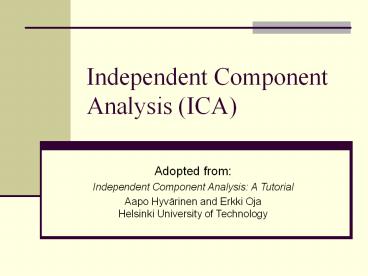Independent Component Analysis (ICA) - PowerPoint PPT Presentation
Title:
Independent Component Analysis (ICA)
Description:
Independent Component Analysis (ICA) Adopted from: Independent Component Analysis: A Tutorial Aapo Hyv rinen and Erkki Oja Helsinki University of Technology – PowerPoint PPT presentation
Number of Views:434
Avg rating:3.0/5.0
Title: Independent Component Analysis (ICA)
1
Independent Component Analysis (ICA)
- Adopted from
- Independent Component Analysis A Tutorial
- Aapo Hyvärinen and Erkki Oja Helsinki University
of Technology
2
Motivation
- Example Cocktail-Party-Problem
3
Motivation
- 2 speakers, speaking simultaneously.
4
Motivation
- 2 microphones in different locations
5
Motivation
- aij ... depends on the distances of the
microphones from the speakers
6
Problem Definition
- Get the original signals out of the recorded ones.
7
Noise-free ICA model
- Use statistical latent variables system
- Random variable sk instead of time signal
- xj aj1s1 aj2s2 .. ajnsn, for all j
- x As
- x Sum(aisi)
- ai ... basis functions
- si ... independent components (ICs)
8
Generative Model
- ICs s are latent variables gt unknown
- Mixing matrix A is also unknown
- Task estimate A and s using only the observeable
random vector x
9
Restrictions
- si are statistically independent
- p(y1,y2) p(y1)p(y2)
- Non-gaussian distributions
- Note if only one IC is gaussian, the estimation
is still possible
10
Solving the ICA model
- Additional assumptions
- of ICs of observable mixtures
- gt A is square and invertible
- A is identifiable gt estimate A
- Compute W A-1
- Obtain ICs from
- s Wx
11
Ambiguities (I)
- Cant determine the variances (energies) of the
ICs - x Sum(1/Ci)aisiCi
- Fix magnitudes of ICs assuming unit variance
Esi2 1 - Only ambiguity of sign remains
12
Ambiguities (II)
- Cant determine the order of the ICs
- Terms can be freely interchanged, because both s
and A are unknown - x AP-1Ps
- P ... permutation matrix
13
Centering the variables
- Simplifying the algorithm
- Assume that both x and s have zero mean
- Preprocessing
- x x Ex
- ICs are also zero mean because of
- Es A-1Ex
- After ICA add A-1Ex to zero mean ICs
14
Noisy ICA model
- x As n
- A ... mxn mixing matrix
- s ... n-dimensional vector of ICs
- n ... m-dimensional random noise vector
- Same assumptions as for noise-free model
15
General ICA model
- Find a linear transformation
- s Wx
- si as independent as possible
- Maximize F(s) Measure of independence
- No assumptions on data
- Problem
- definition for measure of independence
- Strict independence is in general impossible
16
Illustration (I)
- 2 ICs with distribution
- zero mean and variance equal to 1
- Joint distribution of ICs
17
Illustration (II)
- Mixing matrix
- Joint distribution of observed mixtures
18
Other Problems
- Blind Source/Signal Separation (BSS)
- Cocktail Party Problem (another definition)
- Electroencephalogram
- Radar
- Mobile Communication
- Feature extraction
- Image, Audio, Video, ...representation
19
Principles of ICA Estimation
- Nongaussian is independent central limit
theorem - Measure of nonguassianity
- Kurtosis (Kurtosis0 for a gaussian
distribution) - Negentropy a gaussian variable has the largest
entropy among all random variables of equal
variance
20
Approximations of Negentropy (1)
21
Approximations of Negentropy (2)
22
The FastICA Algorithm
23
4 Signal BSS demo (original)
24
4 Signal BSS demo (Mixtures)
25
4 Signal BSS demo (ICA)
26
FastICA demo (mixtures)
27
FastICA demo (whitened)
28
FastICA demo (step 1)
29
FastICA demo (step 2)
30
FastICA demo (step 3)
31
FastICA demo (step 4)
32
FastICA demo (step 5 - end)
33
Other Algorithms for BSS
- Temporal Predictability
- TP of mixture lt TP of any source signal
- Maximize TP to seperate signals
- Works also on signals with Gaussian PDF
- CoBliSS
- Works in frequency domain
- Only using the covariance matrix of the
observation - JADE
34
Links 1
- Feature extraction (Images, Video)
- http//hlab.phys.rug.nl/demos/ica/
- Aapo Hyvarinen ICA (1999)
- http//www.cis.hut.fi/aapo/papers/NCS99web/node11.
html - ICA demo step-by-step
- http//www.cis.hut.fi/projects/ica/icademo/
- Lots of links
- http//sound.media.mit.edu/paris/ica.html
35
Links 2
- object-based audio capture demos
- http//www.media.mit.edu/westner/sepdemo.html
- Demo for BBS with CoBliSS (wav-files)
- http//www.esp.ele.tue.nl/onderzoek/daniels/BSS.ht
ml - Tomas Zemans page on BSS research
- http//ica.fun-thom.misto.cz/page3.html
- Virtual Laboratories in Probability and
Statistics - http//www.math.uah.edu/stat/index.html
36
Links 3
- An efficient batch algorithm JADE
- http//www-sig.enst.fr/cardoso/guidesepsou.html
- Dr JV Stone ICA and Temporal Predictability
- http//www.shef.ac.uk/pc1jvs/
- BBS with Degenerate Unmixing Estimation Technique
(papers) - http//www.princeton.edu/srickard/bss.html
37
Links 4
- detailed information for scientists, engineers
and industrials about ICA - http//www.cnl.salk.edu/tewon/ica_cnl.html
- FastICA package for matlab
- http//www.cis.hut.fi/projects/ica/fastica/fp.shtm
l - Aapo Hyvärinen
- http//www.cis.hut.fi/aapo/
- Erkki Oja
- http//www.cis.hut.fi/oja/































